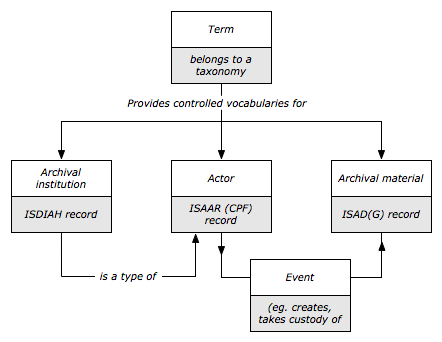Entity types
Please note that ICA-AtoM is no longer actively supported by Artefactual Systems.
Visit https://www.accesstomemory.org for information about AtoM, the currently supported version.
Main Page > User manual > Overview > Entity types
An entity is an object about which an information system collects data. ICA-AtoM's architecture includes a number of entity types, but from a user's point of view there are six main types with which they will interact:
- Accession record
- Archival descriptions
- Authority records
- Archival institutions
- Functions
- Rights records
- Terms
- Developers may be interested in viewing the Entity-relation diagram for the most recent release, located at the Qubit Toolkit wiki: ERD
Accession record
- Accession records provide administrative and descriptive information that identifies the contents, provenance and disposition of the materials transferred to the archival institution. The accession record is designed to establish basic intellectual and physical control over a new accession at the time it is received by the archival institution.
- The accession record is not aimed at end-user description, but ICA-AtoM provides the option to create an archival description from an accession record. The following archival description fields inherit the data entered into the accession record: title, name of creator, archival/custodial history, scope & content and physical condition. Name access points and Rights added to the accession record are inherited into the archival description.
- In ICA-AtoM the accession record includes data entry fields to capture donor information (e.g., donor name and contact information) and rights information (e.g., type of act, rights holder, dates and basis of rights). Once created, Donor records and Rights can be managed separately.
Archival descriptions
Archival descriptions provide contextual information about archival materials and are arranged into hierarchical levels (fonds, series, files, items). The default archival description edit template contains data elements based on the ICA's General International Standard Archival Description (ISAD). Other edit templates are also available: Dublin Core,The US Library of Congress' Metadata Object Descriptive Schema (MODS),and Canadian Rules for Archival Description (RAD).
Authority records
Authority records provide descriptions of the actors (corporate bodies, persons, and families) that interact with archival materials as creators, custodians, subject access points, etc. The edit template is based on the ICA's International Standard Archival Authority Records (Corporate bodies, Persons, Families) (ISAAR).
Authority records are linked to archival descriptions in ICA-AtoM by events delimited by start/end dates. Through events, one actor can have zero, one, or many relationships to zero, one, or many archival units; and one archival unit can have zero, one, or many relationships to zero, one, or many actors. Event relationships link ISAAR authority files (descriptions of actors) and ISAD records (descriptions of archival materials)
Archival institutions
Archival institution records provide descriptions of repositories that preserve and provide access to archival materials. The edit template is based on the ICA's International Standard for Describing Institutions with Archival Holdings (ISDIAH).
Archival institutions are actors that hold archival materials. Like all actors, an archival institution has its own ISAAR authority record. But its characteristics as a repository (e.g. its opening hours, research services, contact information) are described separately in an ISDIAH institution record. The ISDIAH elements that are inherited from its ISAAR authority record are: authorized form of name, other forms of name, parallel forms of name, history, mandates/sources of authority, and administrative structure
Functions
Functions provide a means of describing the activities of records creators and other actors linked to records creation and maintenance. Analysis of the functions of corporate bodies is important as the basis for many recordkeeping activities. Functions are recognised as generally being more stable than administrative structures, which are often amalgamated or devolved when restructuring takes place. Functions are therefore well suited to act as a basis for the appraisal, arrangement, classification and description of records, and as a tool for the retrieval and analysis of records.
In ICA-AtoM the functions edit template is based on the ICA's International Standard for Describing Functions (ISDF). Functions are linked to authority records and to other functions.
Rights records
Rights records provide rights related restrictions that can be linked to accession records, archival descriptions and digital objects. ICA-AtoM Rights metadata elements use PREMIS rights elements. In ICA-AtoM restrictions can be based on Copyright(s), License, Statute(s) and Policy. Rights are inherited in ICA-AtoM, which means that rights added at a higher level (e.g., fonds level) are inherited by the lower levels (e.g., item level). If you add rights to an accession, all archival descriptions created from that accession will inherit the same rights. If you add rights to an archival description at the fonds or collections level, all lower levels, such as the file or item-level will inherit those rights.
Terms
Terms provide controlled vocabularies used throughout the system (e.g. as access points or in drop down value lists). They are organized into separate taxonomies.
